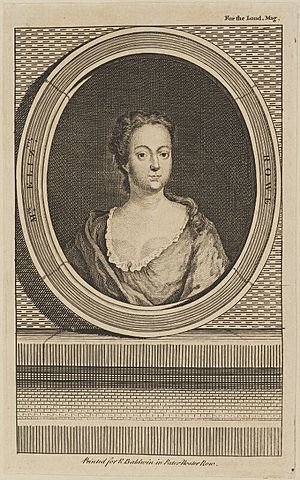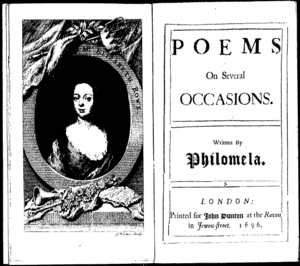Elizabeth Singer Rowe facts for kids
Quick facts for kids
Elizabeth Singer Rowe
|
|
|---|---|

Etching of Elizabeth Singer Rowe, c. 1750—1752, printed for Richard Baldwin (NPG)
|
|
| Born | 11 September 1674 Ilchester, Somerset |
| Died | 20 February 1737 (aged 62) |
| Resting place | Rook Lane Congregational Church |
| Pen name | Philomela; the Pindarick Lady |
| Occupation | Poet, essayist and fiction writer |
| Notable works | Friendship in Death (1728) |
| Spouse | Thomas Rowe |
| Relatives | Elizabeth Portnell (mothere); Walter Singer (father); Anne Finch (aunt) |
Elizabeth Singer Rowe (1674–1737) was an English writer. She wrote poems, essays, and stories. She was one of the most popular authors in England during the 1700s. Her most famous book, Friendship in Death (1728), is a collection of imaginary letters. These letters are from people who have died, writing to the living.
Rowe wrote mostly religious poems. But her most famous work was different. She was very social and involved in her local community in Frome. She remained popular for a long time, even in other countries. Today, experts say her writing style was very new and bold for her time.
Contents
- About Elizabeth Singer Rowe
- Elizabeth Rowe's Literary Works
- Poems on Several Occasions (1696)
- Divine Hymns and Poems on Several Occasions (1704)
- Poems on Several Occasions (1717)
- Friendship in Death, in Twenty Letters From the Dead to the Living (1728)
- Letters on Various Occasions, in Prose and Verse (1729)
- Letters Moral and Entertaining (1729–32)
- The History of Joseph (1736)
- Philomela: or, Poems by Mrs. Elizabeth Singer {now Rowe} (1737)
- Devout Exercises of the Heart in Meditation and Soliloquy, Prayer and Praise (1737)
- The Miscellaneous Works in Prose and Verse of Mrs Elizabeth Rowe (1739)
About Elizabeth Singer Rowe
Elizabeth Singer Rowe was born on September 11, 1674. Her birthplace was Ilchester, Somerset, England. She was the oldest daughter of Elizabeth Portnell and Walter Singer. Her father was a "dissenter" minister. This meant he was a Protestant who did not agree with the Church of England.
Her Early Life and Education
Elizabeth's parents met when her mother was helping people in prison. Her father was held there with other Dissenters. After they married, her father stopped being a minister. He became a cloth maker instead. Elizabeth's father loved her very much. He made sure she had a good education.
She learned about Nonconformist beliefs. In these churches, women could speak in public. They could also help choose ministers. Elizabeth was very active in her local church. Her father also taught her to love books, music, and painting. She may have gone to a boarding school too.
Her Appearance
Theophilus Rowe, Elizabeth's brother-in-law, wrote about her. He said she was not a "regular beauty." But she had many lovely qualities. She was of average height. Her hair was a beautiful reddish-brown color. Her eyes were dark gray, almost blue, and full of life. Her skin was very fair. A natural pink blush showed on her cheeks. She spoke gracefully. Her voice was very sweet and pleasant. It matched the gentle words she always spoke.
Family Life and Marriage
Elizabeth's mother died when Elizabeth was about 18. Her father then moved the family to Egford Farm in Frome, Somerset. There, she learned French and Italian. Her teacher was Henry Thynne. He was the son of the first Viscount Weymouth.
Elizabeth made important friends at Longleat, the Viscount's home. These friends helped her writing career. She also became lifelong friends with Frances Thynne, the Viscount's daughter. Frances's great-aunt, Anne Finch, was also a poet. She wrote a poem that mentioned Elizabeth around 1713. The Thynne family and Anne Finch became her supporters.
Many famous writers wanted to marry Elizabeth. These included John Dunton, Matthew Prior, and Isaac Watts. But she married the poet Thomas Rowe in 1710. He was 13 years younger than her. Their marriage was said to be very happy. However, it was short. Thomas died of tuberculosis in 1715. After his death, Elizabeth left London. She returned to Frome. She lived with her father in Rook Lane House. There is a plaque there to remember her.
Later Life and Death
Elizabeth's father died in 1719. She received a large amount of money from him. She gave half of this money to charity each year. Elizabeth once wrote, "My letters ought to be call'd Epistles from the Dead to the Living." She carefully organized her papers before she died. She even wrote goodbye letters to her friends. It seems she planned her own "good death" event.
She died on February 20, 1737, from a stroke. She was buried with her father. Her grave is at Rook Lane Congregational Church.
Elizabeth Rowe's Literary Works
Elizabeth Rowe started writing at age 12. She was very talented for her age. She probably wrote without her parents knowing. At 19, she began writing letters to John Dunton. He was a bookseller and started a group called the Athenian Society. Dunton later wrote a long, funny, and strange summary of their relationship. It was called "The Double Courtship."
From 1693 to 1696, Elizabeth wrote most of the poems for Dunton's newspaper, The Athenian Mercury. But she later regretted working with him. She felt he used her for his business. Other writers made fun of his style.
Many of her poems from this time were printed again. They appeared in a book called Poems on Several Occasions. She wrote under the names Philomela and the Pindarick Lady. She copied the style of Pindar, an ancient Greek poet. Pindar's way of writing odes (long, formal poems) about big ideas was popular in the late 1600s.
Poems on Several Occasions (1696)
This collection was published by John Dunton. Elizabeth was 22 years old. She used the name Philomela for these poems.
Divine Hymns and Poems on Several Occasions (1704)
This book came out in 1704. Elizabeth was the main poet in this collection. It had religious poems that taught lessons. Other poets like Richard Blackmore and John Dennis were also in it.
Poems on Several Occasions (1717)
This collection includes poems about nature and hymns. It also has a poem that strongly defends women's right to write poetry. This book included one of her most famous poems. It was called "On the Death of Mr. Thomas Rowe." She wrote it after her husband died too soon. This poem is said to have inspired Alexander Pope's Eloisa to Abelard (1720). Pope even put it in the second edition of his work. In her poem, she wrote that she would "retire" from the world. She would live in quiet places and keep her sadness to herself. She kept her promise. She moved back to her father's house in Frome.
Friendship in Death, in Twenty Letters From the Dead to the Living (1728)
This was Elizabeth's most popular work. It was first published in 1728. By 1825, it had been printed at least 79 times. By 1840, it had 10 more editions. In the 1700s, this book was printed more often than Daniel Defoe's Robinson Crusoe. It was also more popular than Samuel Richardson's Clarissa.
The book is made of imaginary letters. These letters are from good friends and loved ones who have died. They have gone to heaven. They want to share spiritual advice. Their main goal is to make sure their friends and family also go to heaven. The letters talk about moral problems and issues of the time. Many letters are like moral essays. Others are more like stories from novels.
In the introduction, Elizabeth said why she wrote the book. She wanted to show that the soul lives forever. She believed that without this idea, all good behavior and religion would fall apart. The spirits in the book say that death should be welcomed. They say it should not be feared. This is because the soul feels great joy in heaven.
Elizabeth's main inspiration for Friendship in Death was Tom Brown's Letters from the Dead to the Living (1702). But Brown's book had famous men making funny comments about hell. Friendship in Death used ideas from letter-writing, ghost stories, and religious teachings. It also influenced later books. For example, it affected how death scenes were written in books like Samuel Richardson's Clarissa.
Letters on Various Occasions, in Prose and Verse (1729)
This book includes the first part of Letters Moral and Entertaining.
Letters Moral and Entertaining (1729–32)
Letters Moral and Entertaining was a series of three books. They were fictional letters. They focused on love, marriage, and death. This work also had religious poems, nature poems, and translations. It even included real letters between Elizabeth and Lady Hertford. Part I, published in 1729, was like a follow-up to Friendship in Death.
The History of Joseph (1736)
Elizabeth Rowe's The History of Joseph (1736) is a long poem. It is like other English religious epic poems. An example is John Milton's Paradise Lost. This poem tells the Old Testament story of Joseph in more detail. Elizabeth's poem was influenced by earlier works. These included Richard Blackmore's A Paraphrase of the Book of Job (1700). It also took ideas from Matthew Prior's Solomon, or the Vanity of the World (1718).
Joseph was translated into German. It influenced German poets like Johann Jacob Bodmer and Friedrick Klopstock. Klopstock's epic poem Messias (1749) was also influenced by Paradise Lost. In her poem, Elizabeth criticized bad behavior. She also criticized old pagan myths. She celebrated Joseph as a hero. He showed great purity by resisting the temptations of Potiphar's wife. Elizabeth called her Sabrina in the poem.
Philomela: or, Poems by Mrs. Elizabeth Singer {now Rowe} (1737)
This book was a new printing of her 1696 collection, Poems on Several Occasions.
Devout Exercises of the Heart in Meditation and Soliloquy, Prayer and Praise (1737)
After Elizabeth died, Isaac Watts edited and published her religious writings. This book contained her thoughts and prayers.
The Miscellaneous Works in Prose and Verse of Mrs Elizabeth Rowe (1739)
Theophilus Rowe published this collection after Elizabeth's death. It started with a very praising biography of her. It also included twelve poems written in her honor.




